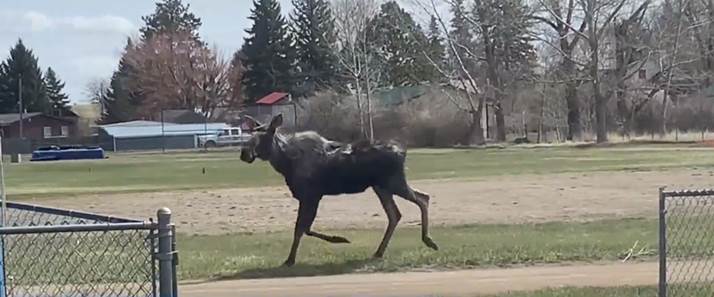
by jhwildlife | Jun 18, 2023 | Blog
By Renee Seidler
At a recent County Commission meeting, Commissioners decided to hold a workshop to discuss proposals to develop the Stilson lot at the corner of WY22 and WY390.
Proposals from Teton County Parks and Recreation may include: multiple softball and soccer fields, fencing around ball fields, pickle ball courts, housing, recycling, a daycare center, a retail shop and a playground.
CLICK FOR DOWNLOADABLE .PDF OF PROPOSED DEVELOPMENT
Wildlife Crossing Structures May Be Compromised
Teton County and WYDOT are spending a combined $7.65 million dollars to build wildlife crossing structures for the safe passage of moose, elk, deer and other species and to reduce wildlife-vehicle collisions. Two of these structures currently open into the Stilson lot area. Proposals to develop this lot could greatly compromise wildlife ability to use and move across the landscape.
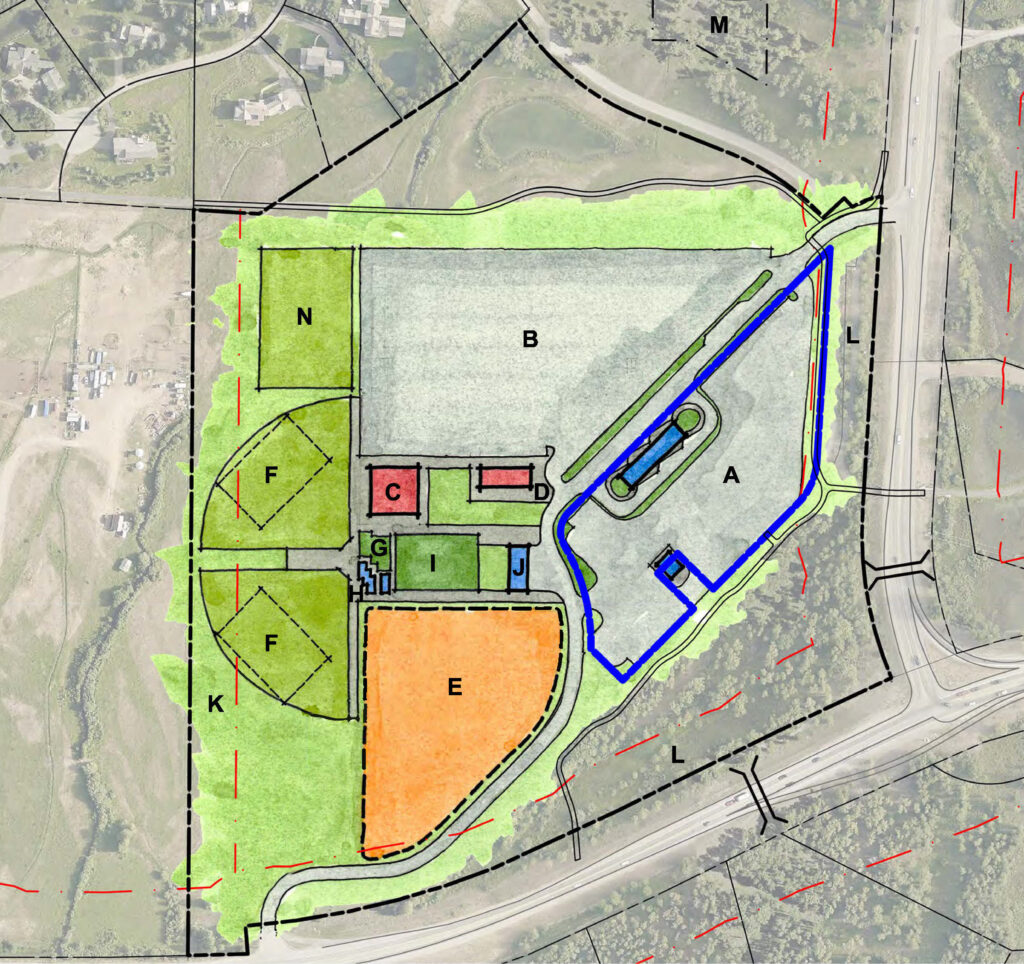
Proposed development plan for Stilson lot area.
Amenities such as ball fields and retail buildings not only take up habitat that animals will no longer be able to use, but they also mean more cars and more people, equating to even greater disturbance to wildlife. Wyoming Game and Fish data show extensive seasonal and year-round use of the Stilson lot by both moose and elk. These animals use the habitat that surrounds the current parking lot for resting, foraging, and migrating.
Teton County Scenic Preserve Trust
Currently, the Stilson lot is ringed by an easement held by the county. This easement was created in 1997 and was meant to preserve Open Space for wildlife habitat, scenic resources, and/or agricultural uses. This easement was gifted to the county by the Jackson Hole Mountain Resort in trade for modified development rights north of Stilson lot, a trade meant to offset the impact of denser development in a rural residential zone. If development expands inside the Stilson easement it could severely reduce the quality of the Scenic Preserve’s Open Space and set a precedent that could challenge the protection of other land easements in our county. In this community, where we have committed to preserve and protect the area’s ecosystem to ensure a healthy environment, community and economy for current and future generations, we cannot afford to lose protected habitat.
Participate in the Process
If you would like to learn more, we encourage you to reach out to your County Commissioners. At the June 26th Board of County Commissioners Workshop, at 10:00 am, there will be an opportunity for public comment. You can also write a letter to the Commissioners and send it to commissioners@tetoncountywy.gov. You can also contact us at the Jackson Hole Wildlife Foundation office with any questions: 307-739-0968. Your voice is important in preserving our ecosystem and wildlife.
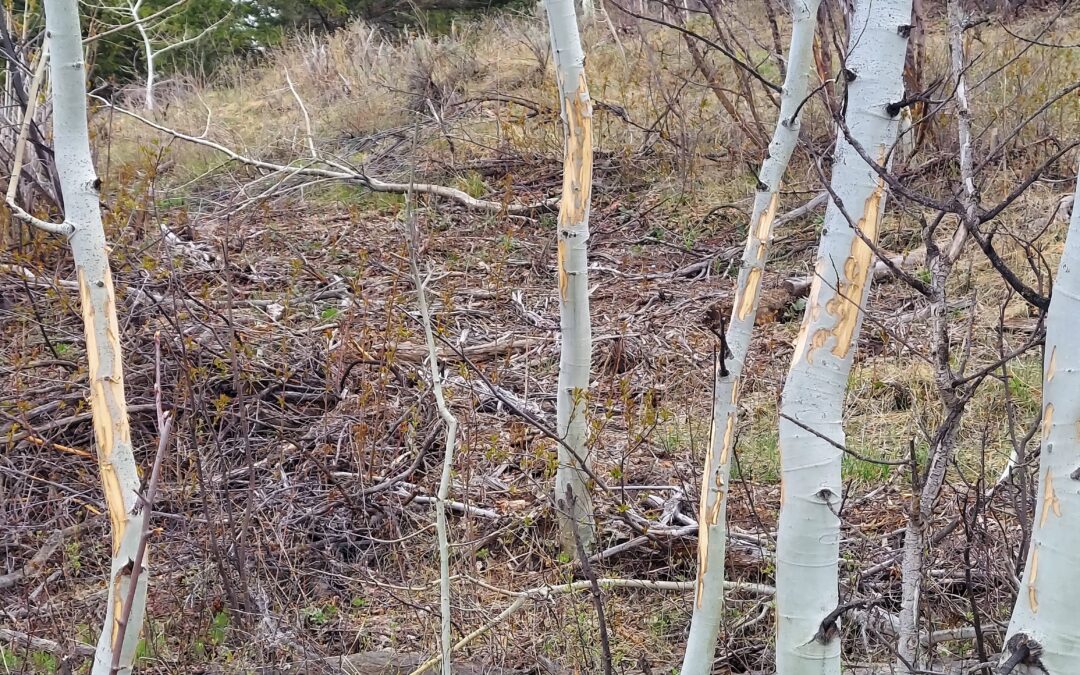
by jhwildlife | May 30, 2023 | Blog
Kyle Kissock
If you’ve been out exploring the Snow King area trails recently you might have noticed an unusual amount of wildlife “browse” on young aspen trees and willows.
The sheer quantity of new browse is one indicator of the importance of this low elevation habitat on the edge of town to deer and moose, which winter here.

The abundance of fresh bark stripping confirms the Snow King area was heavily used by wildlife when winter closures were in place.
While it’s normal for these species to feed on tree bark, bark isn’t necessarily a preferred food source when more nutritious options are available.
Based on the sheer abundance of browse and bark stripping along Josie’s Ridge, Sink or Swim, and other trails, it’s likely protected winter range areas were especially valuable for wildlife this year, given the above average snowpack and prolonged cold temperatures.
And we have good news to share!
While wildlife clearly used the trail system and surrounding habitat, we were thrilled to hear Bridger Teton National Forest reported zero known winter range closure violations this year – a testament to the public’s awareness of the role winter range plays in helping ungulate populations conserve much needed energy.
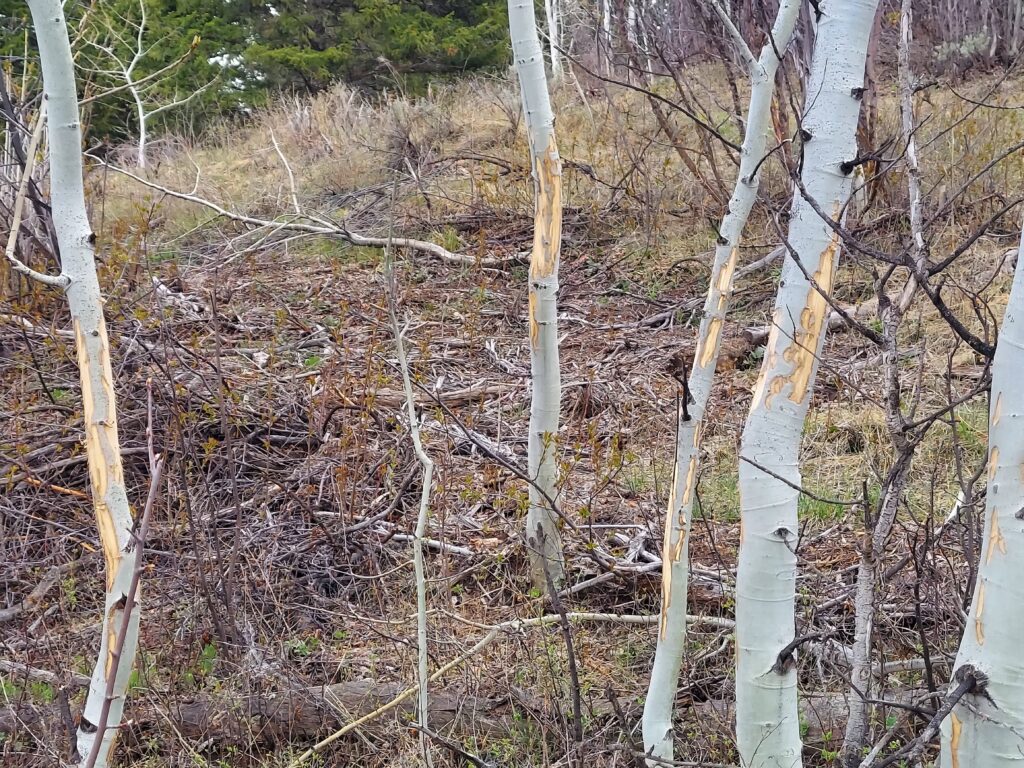
Ungulates are the only animals that strip bark on trees. Porcupines, voles and even black bear may create similar markings.
Exactly how human presence effects wildlife behavior is complex and varies by recreation type, time of year, species impacted, and other factors.
In this case, limiting our footprint in critical areas during a challenging time of year remains one of the most useful tools we have to ensure wildlife is given every chance possible to make it through until a wider variety of habitat becomes available in the spring.
Coming off a rough winter that resulted in abnormally high statewide declines in mule deer and pronghorn, we’d like to thank you for doing your part by abiding by area closures and helping to successfully spread the word this year!
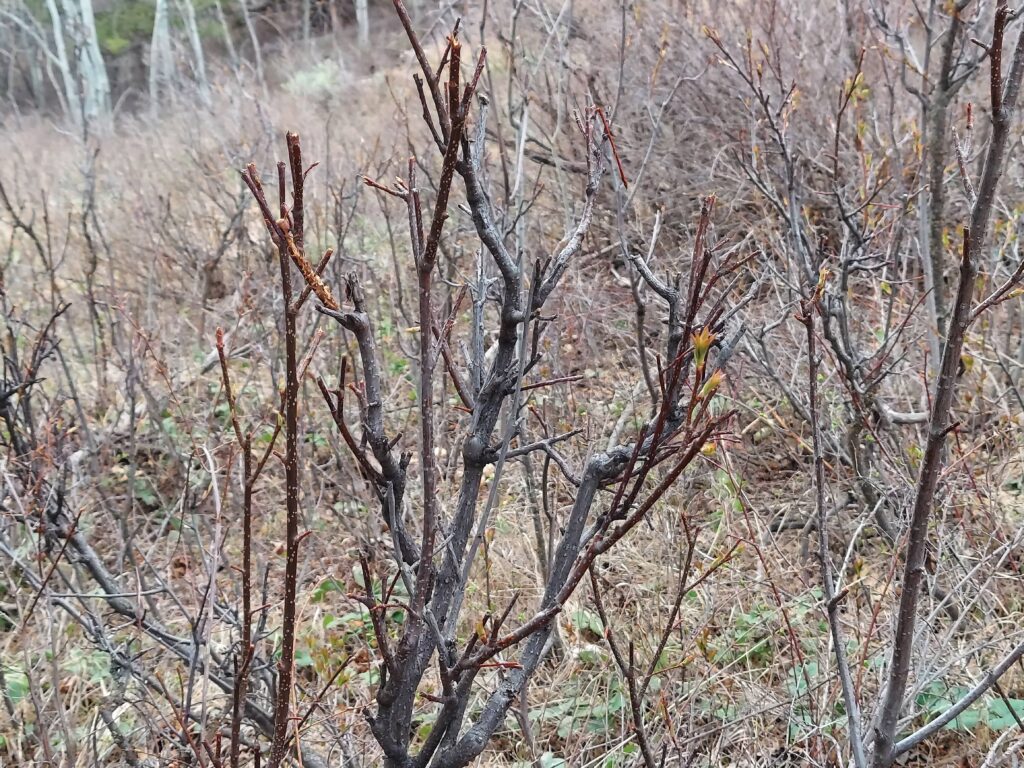
The tips of these willow branches have been munched, likely by moose. This is a common sight in the Cache Creek drainage.
Photos courtesy of Linda Merigliano
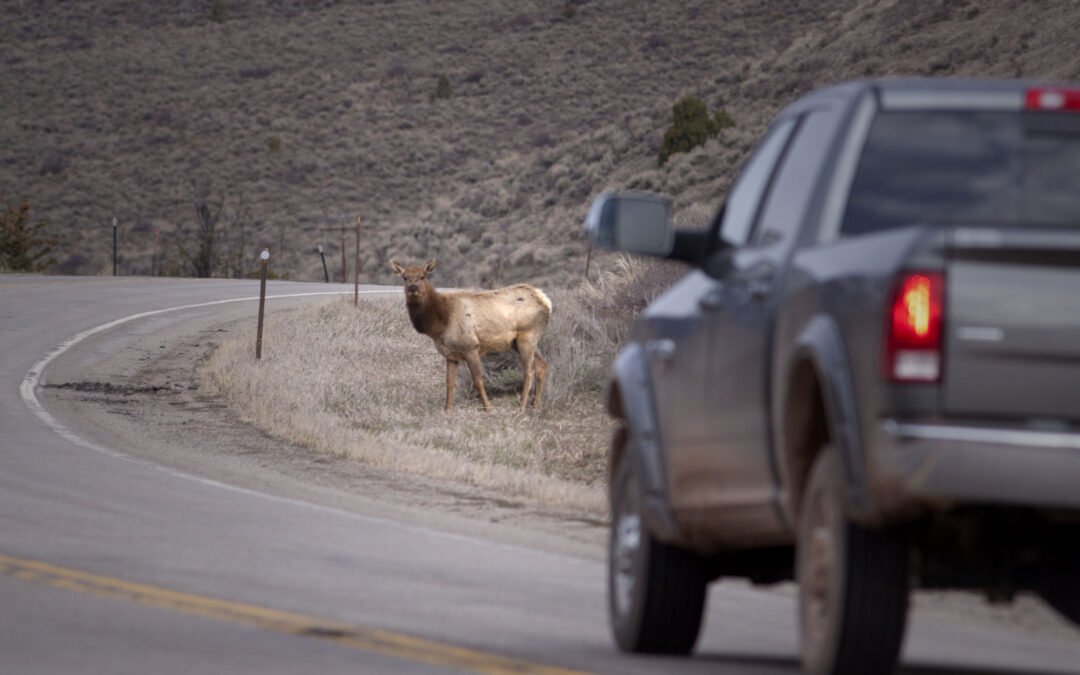
by jhwildlife | Apr 21, 2023 | Blog

A roadside elk near Hoback Junction (photo Mark Gocke).
Have you had a chance to read the 2023 Teton County Annual Indicator Report? Being a science-based conservation organization, we love that Teton County created measurable, achievable goals to strive toward the Vision put forth in our Comprehensive Plan.
One of the indicators that the county looks at in its annual report is wildlife-vehicle collisions (WVCs). The county uses Jackson Hole Wildlife Foundation’s roadkill Nature Mapping data to look at annual changes, a three-year running average of changes and a five-year running average of changes in WVC. The goal is to keep county wide WVC below 206 (the level measured in 2012). From our last report, 165 WVC were reported in 2021, down from 220 the previous year. However, the running averages were both above 206, suggesting that there is still not a significant downward trend.
Despite this news, we expect the county trends to start changing more significantly over the next years to decade, as wildlife crossings are built and funnel fencing directs animals to crossings and keeps them off the road surface. WYDOT has begun construction on the WY 22-390 project which will build four wildlife underpasses and reduce WVC around that intersection. Additionally, Teton County is using some of the Wildlife Crossings Specific Purpose Excise Tax, “SPET”, dollars to have a consultant team (including a well-known road ecologist) create preliminary designs for mitigating three other WVC hotspot areas in the county.
Protecting our wildlife doesn’t always happen quickly, especially when it comes to projects as big as creating wildlife crossings, but patience can bring conservation rewards in due time. We are happy to have been part of this process throughout our 30-year history… we were founded on the goal of reducing wildlife roadkill in Teton County and we remain closely involved today!
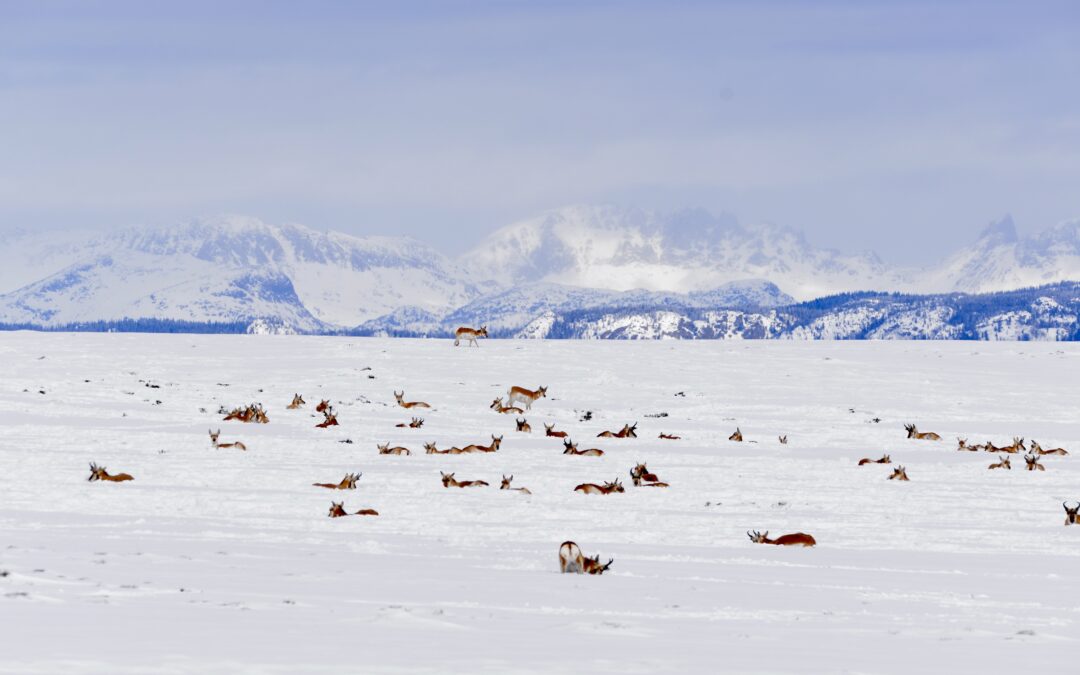
by jhwildlife | Apr 5, 2023 | Blog
By Hilary Turner
As you can imagine, it has been a difficult winter for many ungulates (hoofed mammals) in the Jackson Hole area. Nature Mappers have reported many dead animals, which have succumbed to vehicle collisions, predation, apparent malnutrition, and other unknown causes. Although it can be hard to watch, ungulates evolved with harsh winters. I spoke with wildlife biologists Aly Courtemanch, Ben Wise, and Bill Rudd about how our local ungulates are faring and how you can help.
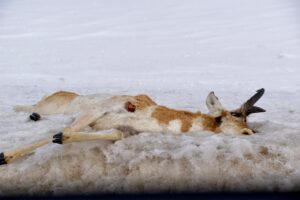
While ungulate populations are well-evolved to endure die-off events over the long term, watching animals struggle through a long winter can be hard to watch.
As many of us have observed, this winter has been hard for many ungulates. Above average snow accumulations lingering longer than usual have been impactful. Smaller ungulates like mule deer can deal with periods of heavy snow and cold snaps, but according to Bill Rudd, what makes a winter especially hard for them is the seasons’ length. This winter, snow started in November and has continued relentlessly. Some of the largest snow accumulations of the winter have come in late-March, making things hard on smaller-bodied ungulates like deer and bighorn sheep, according to Aly Courtemanch. Too, the diel thaw-freeze cycles that occur this time of year exacerbate things for ungulates because a thick ice crust develops, making it hard for ungulates to paw through to snow-covered forage. Deep, crusty snow also forces animals into areas where they are forced to interface with humans, increasing the potential for wildlife-vehicle collisions and other conflicts.
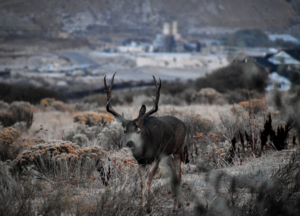
Data from these 200 mule deer in the Wyoming Range show that fawn mortality currently approaches 90% and adult doe mortality approaches 40%.
A subset of the estimated 28,000 mule deer that winter between Evanston and Pinedale and summer in the Wyoming Range have been radio-collared for study by WGFD. Ben Wise shared that data from these 200 animals show that fawn mortality currently approaches 90% and adult doe mortality approaches 40%. Average fawn mortality is estimated to be 20-25% in milder winters. While no collars are deployed in Jackson, Wise has received daily phone calls about dead deer, especially fawns. He explained that fawns are the most resource-limited members of local deer populations and therefore, it is unsurprising that they are the first to succumb to the harsh conditions. However, not all is lost. Wise reminds us that these animals evolved with harsh winters and populations can handle it. Those animals that survive the winter will have more resources per animal, come summer, and will produce healthier fawns. In other words, there may be fewer animals on the landscape, but they will be in better condition.
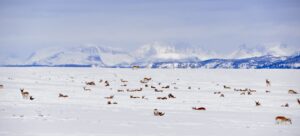
As many as 600 Wyoming pronghorn are known to have died from disease caused by the bacteria Mycoplasma bovis, and many more will likely die as the bacteria works its way through the herd and the long winter wears on.
Pronghorn are also experiencing large die-offs in the Pinedale area. A combination of severe winter conditions that make forage inaccessible and a disease outbreak are negatively impacting them. The herd of approximately 20,000 pronghorn wintering in the Green River Basin is actually comprised of animals that summer in several locations, but some of these animals travel the famous Path of the Pronghorn, migrating into Grand Teton National Park each summer. Courtemanch and Rudd both indicated that biologists will have to wait until animals return to summer range to understand the true impacts of winter and disease on the GTNP population. As many as 600 animals are known to have died from disease caused by the bacteria Mycoplasma bovis, and many more will likely die as the bacteria works its way through the herd and the long winter wears on. Courtemanch indicates that the bacteria is rare in wildlife, but when it reaches pronghorn, it is extremely lethal.
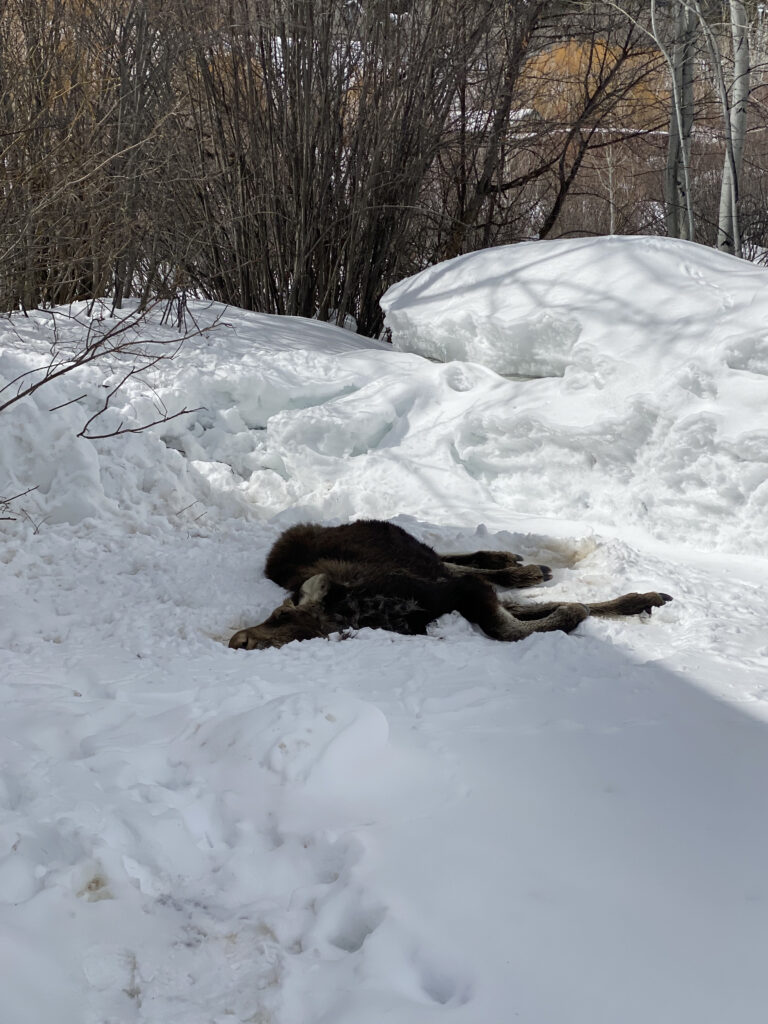
Moose are likely faring better than pronghorn and mule deer this winter, however, well-intentioned artificial feeding can be counter productive. It is also prohibited and enforced by Teton County.
Moose, Courtemanch reminded me, are adapted to cold climates and harsh conditions. They thrive in cold temps and deep snow. Early snow falls may have helped them by shortening the winter tick questing season, when ticks seek moose hosts. Nature Mappers and wildlife biologists alike have observed that moose winter coats are looking better than they have in the past couple of years, which might be due to lighter tick loads. As I spoke with Wise about winter conditions he joked, “moose are doing great!” However, moose are still vulnerable to wildlife-vehicle collisions, which have been the main cause of documented mortalities this winter. Cleared roads are enticing for easier movement and deep snow berms make it difficult for them to move out of the way quickly when vehicles appear. Additionally, feeding hay and other artificial resources is detrimental, particularly to moose. Moose gut biomes can be negatively impacted by things like hay and upset balance in the gut can lead to things like renal failure. In the case of a young bull that recently died in Wilson, Nature Mappers documented the moose drinking excessively, which is unusual this time of year, according to Wise. Most ungulates get the water they need through eating snow. Therefore, when an animal is seen drinking excessive amounts of water, it can be an indication of neurological issues or renal failure, which often happens when moose ingest artificial food sources, like hay, rather than the woody resources they should be ingesting this time of year.
When asked what humans can do to help animals through this brutal winter, all three biologists gave the same answer – Give them space!
- Leash your dog to help animals during the next few critical weeks. As ungulates burn through the last of their fat reserves, they cannot tolerate extra energy expenditure, such as that forced when dogs chase them. Even in areas where it is not required, leashing your dog may be the difference between life and death for a wintering ungulate.
- Respect winter closures to make a difference for ungulates. Critical areas are protected to help animals make it through the toughest part of the winter, which is right now.
- Even though we may be tempted to help wildlife by giving them some extra food, this is more detrimental than beneficial. To help wildlife this winter, do not feed them.
- Carry bear spray to protect yourself and animals. Animals that injure humans are often euthanized. You can prevent this by carrying bear spray to prevent a negative encounter with any animal.
- Give wildlife a brake, especially now. Slow down and scan borrow pits for wildlife to prevent mortality.
- Support agencies and organizations like WGFD and JHWF that are working to advance wildlife conservation over the long term.

by jhwildlife | Mar 14, 2023 | Blog
We want to give a final shout out to the 139 volunteers who joined us for our 14th annual Moose Day survey last month. As far as we know this was a record number of participants, as this Jackson Hole (and now Teton Valley) community tradition continues to grow!
In case you missed it, KHOL and Buckrail both reported on this year’s Moose Day. You can find the KHOL story here and the Buckrail story here.
In addition to these features, volunteer organizer France Clark shared her personalized post-Moose Day report with volunteers last week. Frances’s blog can be accessed here for those of you who didn’t receive it via email.

Moose in Cache Creek by Mitchell McClosky
While we won’t have official numbers until data is vetted and duplicated sightings are removed by the Wyoming Game and Fish Department, some highlights from the report include:
- 382 volunteer hours contributed to the survey
- 42 total survey areas covered
- 8 total Teton Valley, ID survey locations
- As many as 113 moose sightings, roughly on par with what we’ve observed in previous years (note: expect this number to change slightly after observations are vetted)
- Participation from two wildlife tour companies (Buffalo Roam and Ecotour Adventures)
- 13 participants on the Cache Creek “moose walk”
Anecdotally, the deep snow may have limited moose sightings in areas where moose are generally spotted.
There were no moose observed in Ditch Creek or around the airport. Moose were also not observed in the Town of Jackson. On the other hand, there were quite a few moose spotted along creek and river bottoms, including Cache Creek, the Snake River Corridor, and even Pacific Creek up north.
Final counts from 2021 and 2022 were 108 and 101, respectively, so we might expect this year’s count to be similar even if a few duplicate sightings are removed.
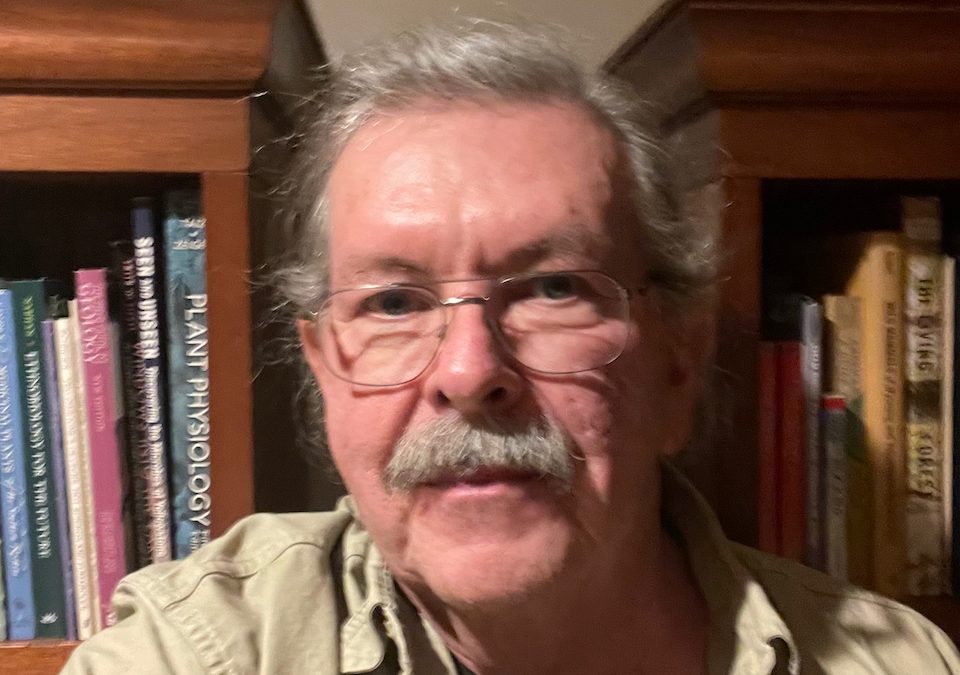
by jhwildlife | Mar 2, 2023 | Blog
NMJH Welcomes Bernie McHugh!
This March, we’re excited to welcome Bernie McHugh as a new data vetter for Nature Mapping Jackson Hole. Bernie is a longtime bird enthusiast and Wilson resident. As a data vetter, Bernie will review wildlife observation submissions and occasionally reach out to Nature Mappers about unusual sightings or errors in data. This process ensures integrity in the Nature Mapping dataset, meaning that agency partners and other end users can rely on its quality.
Bernie McHugh is a semi-retired businessman from New England who has been doing non-profit conservation work since the late ’80’s a volunteer, staff member, board member and executive director.
He and Frances Clark moved to Jackson Hole in 2011 to experience – and help protect – the most intact temperate ecosystem in the Lower 48. He has been the secretary of the JH Bird & Nature Club since 2012 and previously served as a board officer of the Jackson Hole Conservation Alliance.
He is currently president of Montana Audubon, an independent group not affiliated with National Audubon. He has seen 638 North American bird species – and is still counting.
















